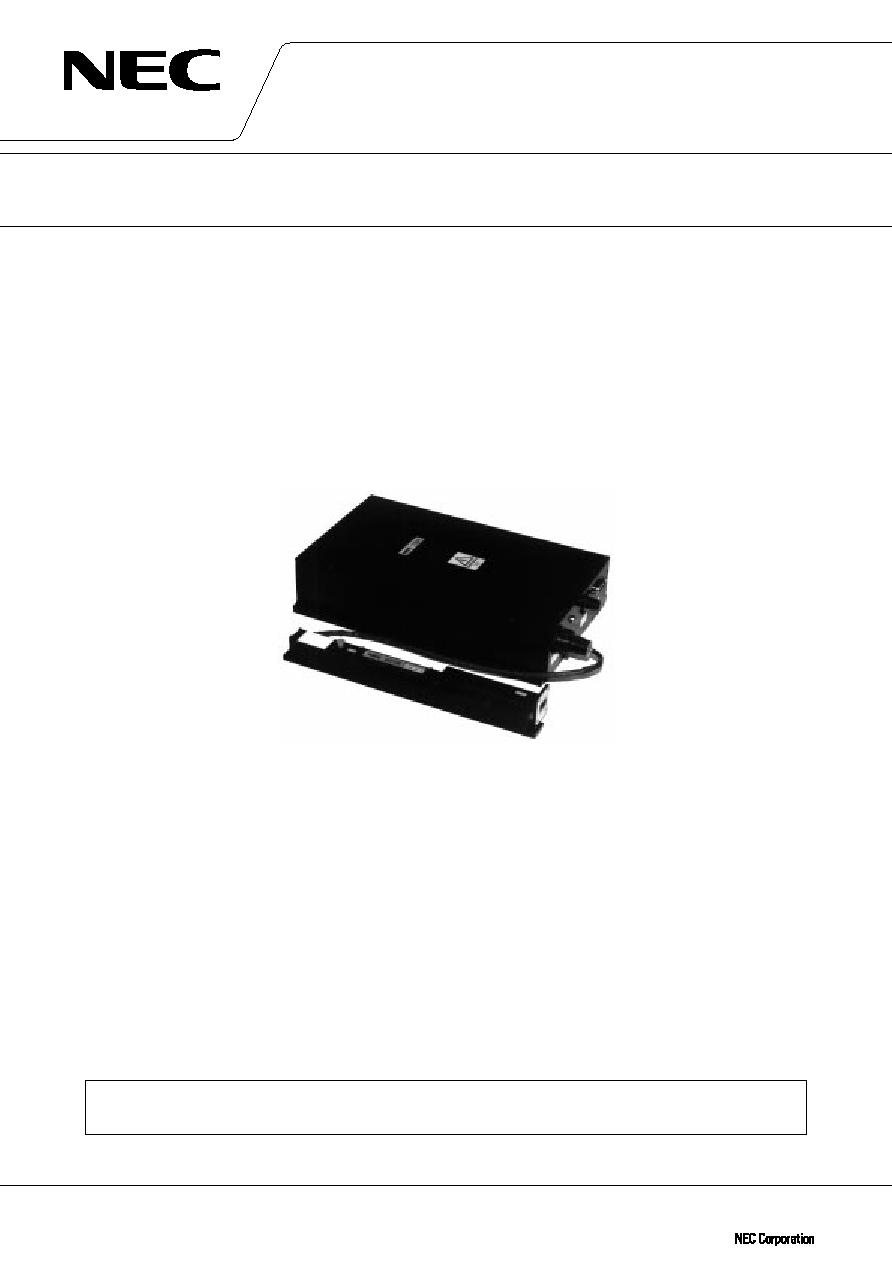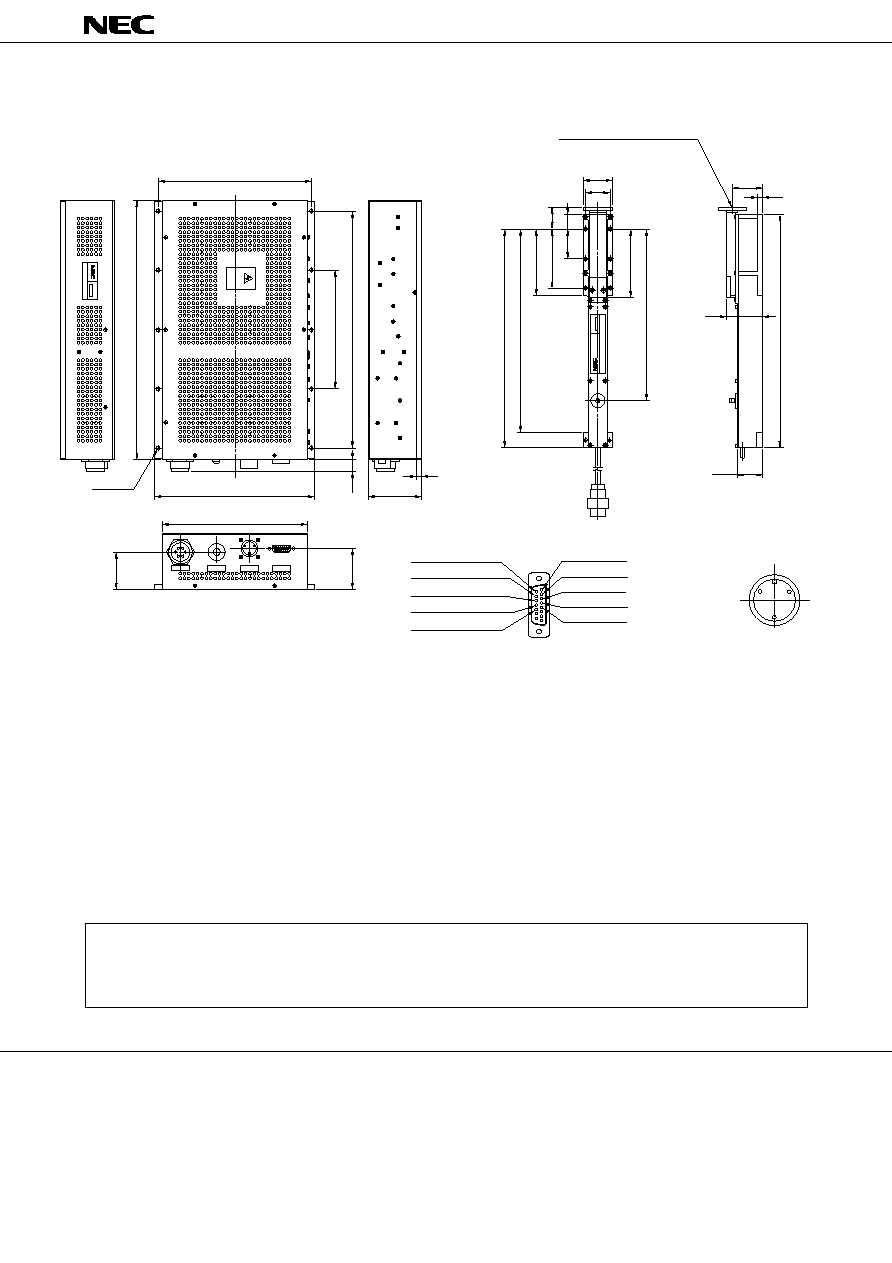 | –≠–ª–µ–∫—Ç—Ä–æ–Ω–Ω—ã–π –∫–æ–º–ø–æ–Ω–µ–Ω—Ç: LD79U12K | –°–∫–∞—á–∞—Ç—å:  PDF PDF  ZIP ZIP |

DATA S H E E T
Document No. ET0224EJ2V0DS00
Date Published September 1998 M
Printed in Japan
14 GHz, 123 W CW, LIGHT WEIGHT, COMPACT, EFFICIENT
The information in this document is subject to change without notice.
©
1996
TRAVELING WAVE TUBE AMPLIFIER
FOR GROUND TERMINALS
LD79U12K
For safe use of microwave tubes, refer to NEC document "Safety instructions to all personnel
handling electron tubes" (ET0048EJ
V
UM00)
GENERAL DESCRIPTION
NEC TWTA (Traveling Wave Tube Amplifier) LD79U12K delivers an output power of 123 W over the range of
13.75 to 14.5 GHz with a gain of 50 dB.
The Traveling Wave Tube (TWT : LD7246A) in the LD79U12K has been designed and developed upon the NEC's
advanced technology and enormous experience on a number of TWTs used in satellite ground terminals and ter-
restrial microwave links.
The very small and light weight Electric Power Conditioners (EPC) designed with sophisticated and experienced
circuit technology ensures higher reliability, reduced maintenance costs and improved technical perform-
ance.
The LD79U12K is most suitable for a power amplifier in digital communication systems.
FEATURES
TM Light weight, Compact, and Efficient
The TWT has a dual-depressed collector and is designed to operate at high efficiency across the power output
range. The EPC features state-of-the-art techniques to optimize size and efficiency and the combination results
in a unit significantly smaller and with less power consumption than a comparable solid state amplifier.
TM Low Distortion
NEC has developed techniques for the correction of non-linear distortion of gain and phase generated in a TWT.
As a result, the TWTA has optimum performance across a broad power range and is ideally suited for multi-
carrier transmission systems.
TM Long Life
The TWT is designed to have a lifetime of 50,000 hours or more, which in actual usage.
TM Ideal for Digital Systems
A mini-arcing in the electron gun have been eliminated in the TWT used in the TWTA.
TM Wide range of primary voltage

2
LD79U12K
TYPICAL OPERATIONS
Frequency Range ................................................ 13.75 ≠14.5 GHz
Power Output ................................................... 123 W minimum
Instantaneous Bandwidth .................................... 750 MHz
Gain Variation ................................................... 1.0 dB / 750 MHz
Gain
............................................................... 53 dB (at Po = 123 W)
60 dB (at small signal)
Gain Stability
...................................................
±
0.25 dB / 24 h (25∞C
±
10∞C)
Gain Slope ......................................................... 0.03 dB / MHz
Harmonic Output ................................................ 10 dB below at rated output power
Spurious Output ................................................ ≠70 dBW in any 4 kHz band
in the 13.75 to 14.5 GHz
AM to PM Conversion
....................................... 4∞ / dB maximum at rated power
Intermodulation ................................................ 18 dB below each of two equal 45 dBm carriers
Group Delay
Linear component .......................................... 0.1 ns / MHz
Parabolic component ....................................... 0.01 ns / MHz
2
Ripple component .......................................... 1.0 ns (p-p) in any 40 MHz band
RF Input
Connector ...................................................... Mates with Type SMA Female
VSWR ............................................................ 2.0 : 1 maximum
Load VSWR ................................................... Operate into 1.5 : 1 maximum
RF Output
Waveguide
................................................... Mates with BRJ-120 Flange
VSWR ............................................................ 2.0 : 1 maximum
Load VSWR ................................................... Operate into 1.5 : 1 maximum
Primary Power ................................................... 85 Vac-255 Vac
(450 VA)
Power Factor ...................................................... 0.9 minimum
Electrical Connections
AC IN ............................................................ JL04V-2E10SL-3PE-B Connector
CONT & MON ................................................ DA-15P-N D-Sub Connector
Dimensions ...................................................... TWT : 315 x 40 x 50 mm
EPC : 350 x 220 x 75 mm
Weight ............................................................... TWT : 1.3 kg
EPC : 5 kg
ENVIRONMENTAL CONDITIONS
TM Ambient Temperature
0∞C to +45∞C (operating)
≠30∞C to +70∞C (non operating, storage)
TM Relative Humidity
90% maximum (non dewing)
TM Base Plate Temperature of the TWT
+90
∞
C maximum

3
LD79U12K
Note 1 : These characteristics and operating values may be changed as a result of additional information or
product improvement. NEC should be consulted before using this information for equipment design.
This data sheet should not be referred to a contractual specification.

LD79U12K
NEC Corporation does not assume any liability for infringement of patents, copyrights or other intellectual
property rights of third parties by or arising from use of a device described herein or any other liability arising
from use of such device. No license, either express, implied or otherwise, is granted under any patents, copy-
rights or other intellectual property rights of NEC Corporation or others.
LD79U12K OUTLINE (Unit in mm)
1. HV ON CMD
2. HV ON RESP
3. Ihel ALM
4. Ihel MON
5. STAND BY
10. HV ON RESP. COM
9. HV ON CMD COM
11. Ihel ALM COM
12. Ihel MON COM
13. STAND BY COM
N
E
C Cor
por
a
tion
MADE IN J
A
P
A
N
N
E
C
Cor
p
or
ation
MADE IN J
A
P
A
N
W
ARNING
CONT
ACVIN
HV/ON
HV/OUT
210
40
RF Output
Mates with FURB-120 Flange
41.8
50
35.4
AC
AC
GND
A
B
C
7
34
350
160
320
295
275
90
93
315
231.5
30
80
20
40
18
55
50
220
10 - 4.5
200
75
7
Pin Connection
(D-sub. 15 pins)
(Note 1-5)
AC IN : MS3102A 14S-7P (3 pins)
CONT : DA-15P-N D-Sub connector (15 pins)
Pin Connection (AC IN)
Note 1. HV ON/OFF RESPONSE SIGNAL : Photocoupler Interface (No.2: Collector, No.10: Emitter)
HV ON : No.2 and No.10 conduct
2. Ihel ALM Signal : Photocoupler Interface (No.3: Collector, No.11: Emitter)
Ihel ALM Signal ON : No.3 and No.11 conduct
3. Ihel Monitor (No.4, No.12) : 1 V/mA
4. HV ON : When No.1 and No.9 conduct, TWT will be ready to amplify
5. STANDBY : After the heater warms up, No.6 and No.15 will conduct.



